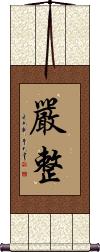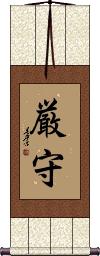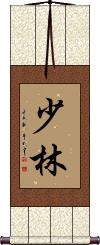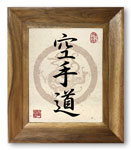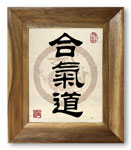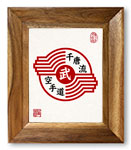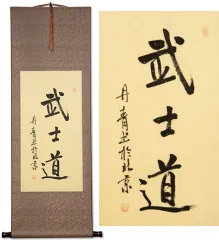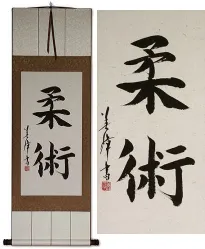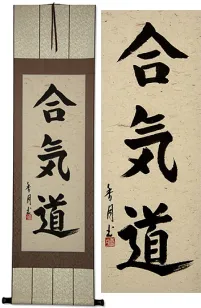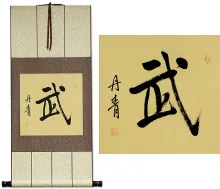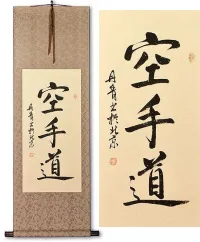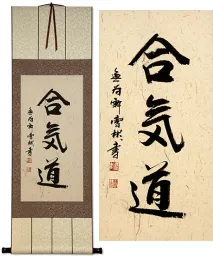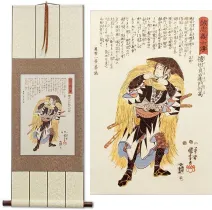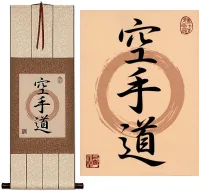Many custom options...
And formats...

Not what you want?
Try other similar-meaning words, fewer words, or just one word.
Well Disciplined in Chinese / Japanese...
Buy a Well Disciplined calligraphy wall scroll here!
Personalize your custom “Well Disciplined” project by clicking the button next to your favorite “Well Disciplined” title below...
Well-Disciplined / Orderly
Special Military Term
When reading an account of some battles in China, I came across the Chinese word, 嚴整. As it turns out, 嚴整 is only used in military circles to describe neat, orderly, and well-disciplined troops. Perhaps this is actually closer to the meaning I was taught while in the U.S. Marines.
The first character literally means stern, serious, strict, or severe (it can also mean airtight or watertight.
The second character means exact, in good order, whole, complete, and orderly.
Together, these two characters multiply each other into a word that expresses the highest military level of discipline.
See Also: Self-Control | Will-Power
Well-Disciplined / Scrupulous Compliance
Shaolin
Little Forest
The 少林 or Shaolin monks of China have been practicing the art of Kung Fu for thousands of years. While there are many schools of Kung Fu in China, Shaolin are one of the more religiously devout and disciplined.
The title of Shaolin actually refers to a specific Buddhist monastery. It should be noted that the Shaolin were famous in China long before the Kung Fu TV show. Their fame in China is due to the monks' heroic and swift rescue of an emperor during the Tang Dynasty. Most Chinese people are not keenly aware of the Kung Fu TV show and have no idea who David Carradine is or anything about his character, Kwai Chang Caine.
Note: The literal meaning of 少林 is “little forest.”
The fame of the Shaolin has spread all over Asia, as even though this is a Chinese title, the same characters are used in Japanese with the same meaning.
This in-stock artwork might be what you are looking for, and ships right away...
Gallery Price: $72.00
Your Price: $39.88
Gallery Price: $87.00
Your Price: $47.88
Gallery Price: $268.00
Your Price: $148.77
Gallery Price: $200.00
Your Price: $98.88
Gallery Price: $90.00
Your Price: $49.88
Gallery Price: $108.00
Your Price: $59.88
Gallery Price: $90.00
Your Price: $49.88
Gallery Price: $106.00
Your Price: $58.88
Gallery Price: $200.00
Your Price: $69.88
Not the results for well disciplined that you were looking for?
Below are some entries from our dictionary that may match your well disciplined search...
| Characters If shown, 2nd row is Simp. Chinese |
Pronunciation Romanization |
Simple Dictionary Definition |
釋迦牟尼 释迦牟尼 see styles |
shì jiā móu ní shi4 jia1 mou2 ni2 shih chia mou ni Shakamuni |
More info & calligraphy: Shakyamuni / The Buddha釋迦文 (釋迦文尼); 釋伽文 Śākyamuni, the saint of the Śākya tribe. muni is saint, holy man, sage, ascetic monk; it is: intp. as 仁 benevolent, charitable, kind, also as 寂默 one who dwells in seclusion. After '500 or 550' previous incarnations, Śākyamuni finally attained to the state of Bodhisattva, was born in the Tuṣita heaven, and descended as a white elephant, through her right side, into the womb of the immaculate Māyā, the purest woman on earth; this was on the 8th day of the 4th month; next year on the 8th day of the 2nd month he was born from her right side painlessly as she stood under a tree in the Lumbinī garden. For the subsequent miraculous events v. Eitel. also the 神通遊戲經 (Lalitavistara), the 釋迦如來成道記, etc. Simpler statements say that he was born the son of Śuddhodana, of the kṣatriya caste, ruler of Kapilavastu, and Māyā his wife; that Māyā died seven days later, leaving him to be brought up by her sister Prājapati; that in due course he was married to Yaśodharā who bore him a son, Rāhula; that in search of truth he left home, became an ascetic, severely disciplined himself, and finally at 35 years of age, under a tree, realized that the way of release from the chain of rebirth and death lay not in asceticism but in moral purity; this he explained first in his four dogmas, v. 四諦 and eightfold noble way 八正道, later amplified and developed in many sermons. He founded his community on the basis of poverty, chastity, and insight or meditation, ad it became known as Buddhism, as he became known as Buddha, the enlightened. His death was probably in or near 487 B.C., a few years before that of Confucius in 479. The sacerdotal name of his family is Gautama, said to be the original name of the whole clan, Śākya being that of his branch, v. 瞿, 喬.; his personal name was Siddhārtha, or Sarvārthasiddha, v. 悉. |
修調 修调 see styles |
xiū tiáo xiu1 tiao2 hsiu t`iao hsiu tiao shujō |
disciplined |
外乞 see styles |
wài qǐ wai4 qi3 wai ch`i wai chi gekotsu |
The mendicant monk who seeks self-control by external means, e. g. abstinence from food, as contrasted with the 内乞 who seeks it by spiritual methods. |
所調 所调 see styles |
suǒ tiáo suo3 tiao2 so t`iao so tiao shojō |
[one] to be trained; disciplined |
罄然 see styles |
qìng rán qing4 ran2 ch`ing jan ching jan |
well disciplined |
老宿 see styles |
lǎo sù lao3 su4 lao su rōshuku |
sthavira, an old man, virtuous elder. |
暮鼓晨鐘 暮鼓晨钟 see styles |
mù gǔ chén zhōng mu4 gu3 chen2 zhong1 mu ku ch`en chung mu ku chen chung boko shinshō |
lit. evening drum, morning bell (idiom); fig. Buddhist monastic practice; the passage of time in a disciplined existence evening drums and morning bells |
秋毫無犯 秋毫无犯 see styles |
qiū háo wú fàn qiu1 hao2 wu2 fan4 ch`iu hao wu fan chiu hao wu fan |
(idiom) (of soldiers) highly disciplined, not committing the slightest offense against civilians |
ストイック see styles |
sutoikku ストイック |
(adjectival noun) (1) stoic; stoical; (adjectival noun) (2) self-disciplined; abstemious; austere; strict (with oneself); (3) Stoic (philosopher) |
The following table may be helpful for those studying Chinese or Japanese...
| Title | Characters | Romaji (Romanized Japanese) | Various forms of Romanized Chinese | |
| Well-Disciplined Orderly | 嚴整 严整 | yán zhěng yan2 zheng3 yan zheng yanzheng | yen cheng yencheng |
|
| Well-Disciplined Scrupulous Compliance | 厳守 | gen shu / gen syu genshu / gensyu | ||
| Shaolin | 少林 | sho rin / shorin | shǎo lín / shao3 lin2 / shao lin / shaolin | |
| In some entries above you will see that characters have different versions above and below a line. In these cases, the characters above the line are Traditional Chinese, while the ones below are Simplified Chinese. | ||||
Successful Chinese Character and Japanese Kanji calligraphy searches within the last few hours...
